Filton Abbey Wood railway station
| Filton Abbey Wood | |
|---|---|
|
View south from the footbridge. | |
| Location | |
| Place | Filton |
| Local authority | South Gloucestershire |
| Coordinates | 51°30′18″N 2°33′45″W / 51.5049°N 2.5624°WCoordinates: 51°30′18″N 2°33′45″W / 51.5049°N 2.5624°W |
| Grid reference | ST609784 |
| Operations | |
| Station code | FIT |
| Managed by | Great Western Railway |
| Number of platforms | 3 |
| DfT category | F1 |
|
Live arrivals/departures, station information and onward connections from National Rail Enquiries | |
| Annual rail passenger usage* | |
| 2002/03 | 0.395 million |
| 2004/05 |
|
| 2005/06 |
|
| 2006/07 |
|
| 2007/08 |
|
| 2008/09 |
|
| 2009/10 |
|
| 2010/11 |
|
| 2011/12 |
|
| 2012/13 |
|
| 2013/14 |
|
| History | |
| Original company | Bristol and South Wales Union Railway |
| Pre-grouping | Great Western Railway |
| Post-grouping | Great Western Railway |
| 1863 | Opened as "Filton" |
| 1903[note 1] | Resited |
| 1910 | Renamed "Filton Junction" |
| 1968 | Renamed "Filton" |
| 1996 | Resited and renamed "Filton Abbey Wood" |
| National Rail – UK railway stations | |
| * Annual estimated passenger usage based on sales of tickets in stated financial year(s) which end or originate at Filton Abbey Wood from Office of Rail and Road statistics. Methodology may vary year on year. | |
|
| |
Filton Abbey Wood railway station serves the town of Filton in South Gloucestershire, England, inside the Bristol conurbation. It is 4.4 miles (7.1 km) from Bristol Temple Meads. Its three letter station code is FIT. There are three platforms but minimal facilities. The station is managed by Great Western Railway, the seventh company to be responsible for the station, and the third franchise since privatisation in 1997. They provide most train services at the station, with two trains per day operated by CrossCountry. The general service level is eight trains per hour - two to South Wales, two to Bristol Parkway, two toward Weston-super-Mare and two toward Westbury.
Filton Abbey Wood is the third station on the site. The first station, Filton, was opened in 1863 by the Bristol and South Wales Union Railway. The station had a single platform, with a second added in 1886 to cope with traffic from the Severn Tunnel. The station was closed in 1903, replaced by a new station, Filton Junction, 0.15 miles (0.24 km) further north, which was built at the junction with the newly constructed Badminton Line from Wootton Bassett. The new station had four platforms, each with waiting rooms and large canopies.
Services at Filton Junction declined in the second half of the twentieth century, with the station buildings and Badminton Line platforms demolished in 1976. The station was closed completely in 1996, replaced by the current station, Filton Abbey Wood. This was built 0.3 miles (0.48 km) south of the original station, adjacent to a new Ministry of Defence office development. The station was built with two platforms, but a third was added in 2004.
The line through Filton Abbey Wood is not electrified, but will be as part of the planned modernisation of the Great Western Main Line. A new platform will also be built, allowing increased services between Bristol Parkway and Bristol Temple Meads.
Description
Filton Abbey Wood railway station is located in the Filton area of South Gloucestershire, within the Bristol conurbation. The area to the west of the station is primarily residential, while to the east is a large commercial area, including MoD Abbey Wood which is adjacent to the station.[1] The main access to the station is via a long footpath (a slope of approximately 1 in 8) and bridge from Emma-Chris Way to the north, which has a small car park.[2][3] There is also foot access from MoD Abbey Wood to the east.[2] The station is on the Cross Country Route between Bristol Temple Meads and Bristol Parkway, and just off the South Wales Main Line south of Patchway and the eastern end of the Henbury Loop Line.[4] It is 4 miles 30 chains (7.0 km) from Bristol Temple Meads and 113 miles 21 chains (182.3 km) from London Paddington (via Bristol Parkway).[5][6][note 2] The station is just north of Filton South Junction, where the northbound line to South Wales and the westbound line to Avonmouth split from the line to Bristol Parkway, and just south of Filton Junction No. 1, where the southbound lines from South Wales and Parkway converge.[4][6] The next station south is Stapleton Road, the next station north is Patchway, and the next station east is Bristol Parkway.[4]
The station is on an alignment of 032 degrees, curving towards the west.[1] There are three active platforms: platform 1 is the easternmost, separated from platforms 2 and 3, which share an island, by two running lines. Platform 1 is for southbound trains and has a speed limit of 70 miles per hour (110 km/h). Platform 2 is for northbound trains towards Bristol Parkway, but can be used by trains towards South Wales. Platform 3 is for northbound trains towards South Wales. Both platforms 2 and 3 have a speed limit of 60 miles per hour (97 km/h), and all three platforms are 108 metres (118 yd) long.[6]
Facilities at the station are minimal - there are metal and glass shelters on each platform, and some seating. A small ticket office operates on platform 1 on weekday afternoons, but there are no other facilities for buying tickets and the station is generally unstaffed. There are customer help points, giving next train information for both platforms, as well as dot-matrix displays showing the next trains on each platform. A small pay and display car park with 30 spaces is to the north of the station, as are racks for eight bicycles. CCTV cameras are in operation at the station.[3] A number of buses stop by the station car park.[7]
Over the decade 2002–2012, passenger numbers at Filton Abbey Wood almost doubled, from 395,000 to 771,000.[8][9][note 3] In the 2006/07 financial year, over 50,000 passengers used Filton Abbey Wood to travel to or from Bristol Temple Meads.[10] The line through Filton Abbey Wood has a loading gauge of W8, and the line handles over 15 million train tonnes per year.[11] It is not electrified, though it is planned that it will be electrified as part of the 21st-century modernisation of the Great Western Main Line.[12]
Services
.jpg)
Filton Abbey Wood is managed by Great Western Railway who operate most services from the station.[3] The basic service Monday to Friday is four trains per hour in each direction, split between four services. These are the hourly services each way between Bristol Parkway and Weston-super-Mare; Taunton and Cardiff Central; Portsmouth Harbour and Cardiff Central; and finally Gloucester and Westbury. The Taunton service has occasional extensions to Exeter St David's and beyond, while the Gloucester to Westbury has alternate hour extensions to Great Malvern (via Worcester) in the north, to Weymouth in the south, and one daily extension to Brighton. Combined, there are two trains per hour to Bristol Parkway, two trains per hour to Cardiff Central and four trains per hour to Bristol Temple Meads.[13][14][15] A single direct service from London Paddington calls at Filton Abbey Wood in the morning, continuing to Swansea, but there are no direct services to London.[16] All services are operated by Great Western Railway, with the exception of one morning and one evening service operated by CrossCountry from Cardiff Central to Manchester Piccadilly via Bristol Temple Meads and Birmingham New Street. The morning service operates to Manchester Piccadilly whilst the evening service returns to Cardiff Central.[17] Other CrossCountry services pass non-stop throughout the day, operating two trains per hour each direction between the South West, Bristol, Manchester and Scotland.[17][18]
The local services described above are formed using Class 150, 153 and 158 diesel multiple-unit trains. Until 2012, Class 143 Pacer units were a regular sight, but these have been moved south to work in Devon and Cornwall following a cascade of Class 150/1 units from London Midland and London Overground.[19][20] The London to Swansea service is operated by an HST set,[16] and CrossCountry services are operated using Class 220 and 221 Voyager diesel-electric multiple units.[17][18]
The standard journey time to Bristol Temple Meads is 8 minutes, to Bristol Parkway is 4 minutes, and to Cardiff Central is 50 minutes.[13][15]
| Preceding station | |
Following station | ||
|---|---|---|---|---|
| Bristol Parkway | Great Western Railway Bristol Parkway - Weston-super-Mare |
Stapleton Road (Limited service southbound) | ||
| Bristol Temple Meads | ||||
| Bristol Parkway | Great Western Railway Great Malvern/Gloucester - Westbury/Weymouth |
Stapleton Road (Southbound only) | ||
| Bristol Temple Meads | ||||
| Patchway | Great Western Railway Cardiff Central - Taunton |
Stapleton Road (Northbound only, limited service) | ||
| Bristol Temple Meads | ||||
| Newport | Great Western Railway Cardiff Central - Portsmouth Harbour |
Bristol Temple Meads | ||
| Great Western Railway London to Swansea (Northbound only, limited service) |
||||
| Patchway | CrossCountry Cardiff Central - Manchester Piccadilly (Limited service) |
Bristol Temple Meads | ||
History
There have been three different stations in the area of Filton Abbey Wood. The first, Filton, opened in 1863 just north the site of the current Filton Abbey Wood, and was closed in 1903.[note 1] A second station was opened a few hundred yards to the north, and was known as Filton Junction.[21] This station closed in 1996, replaced by Filton Abbey Wood.[22]
First station: Filton
The first station at Filton opened on 8 September 1863 when services began on the Bristol and South Wales Union Railway (BSWUR), which ran from Bristol Temple Meads to New Passage Pier, north of Bristol on the banks of the River Severn. At New Passage, passengers were transferred to a ferry to cross the Severn to continue on in to Wales. The line, engineered by Isambard Kingdom Brunel, was built as single track 7 ft 1⁄4 in (2,140 mm) broad gauge, with a platform on the western side of the line.[22][23] The station was situated in the county of Gloucestershire, 4 miles 53 chains (7.5 km) from Bristol Temple Meads and immediately south of the modern bridge over the A4174 Avon Ring Road.[5][22][note 2] The BSWUR was amalgamated with the Great Western Railway, who had from the beginning operated all BSWUR services, in 1868;[24] and in 1873 the line was converted to 1,435 mm (4 ft 8 1⁄2 in) standard gauge.[23] Although the line made travel from Bristol to Wales easier, the change from train to ferry to train was inconvenient, and so a tunnel was built under the River Severn. To cope with the anticipated increase in demand, the line through Filton was doubled,[23] with a new platform built on the eastern side of the new track, complete with waiting room. The new track was first used on 1 September 1886 when the Severn Tunnel opened. The station continued in use until 1 July 1903, when it was closed and replaced by a new station 11 chains (0.22 km) further north.[note 1] There is no trace remaining of the original station.[22]
| Preceding station | Historical railways | Following station | ||
|---|---|---|---|---|
| Patchway | Bristol and South Wales Union Railway (1863-1864) |
Stapleton Road | ||
| Bristol and South Wales Union Railway (1864-1868) |
Ashley Hill Line open, station closed. | |||
| Great Western Railway Bristol and South Wales Union Line (1868-1903)[note 1] |
||||
Second station: Filton Junction
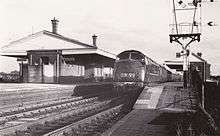
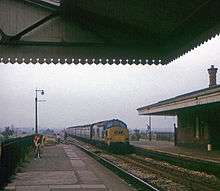
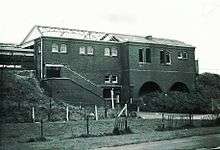
_station_geograph-3517658-by-Ben-Brooksbank.jpg)
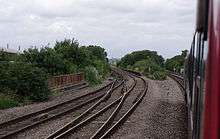
In 1900, almost all trains from London to Wales travelled via Bath and Bristol, with some still routed via Gloucester. However, the final 15 miles (24 km) to Bristol were relatively slow and congested, so a new route was built further north, the GWR's Badminton Line, now part of the South Wales Main Line, running from Wootton Bassett to Patchway. The new line opened in 1903, and allowed faster services to Wales. There was a new triangular junction between Patchway and Filton, with the new line coming in from the east.[25] The new station, opened on 1 July 1903,[note 1] was on an embankment at the southern apex of the junction, just north of the present A4174.[22] It was 11 chains (0.22 km) north of the first station, 4 miles 64 chains (7.7 km) from Bristol Temple Meads and 112 miles 67 chains (181.6 km) from London Paddington via the new line.[5][note 2]
The new station had four platform faces - two outer platforms, and two inner platforms sharing an island between the southbound line from Patchway and the westbound line to London. The western platforms served trains between Bristol and Wales, while the eastern platforms served trains on the new line. The platforms were linked by a subway which led to the booking office, situated on ground level by the main entrance on the east side of the station.[22] The approach road led south from the main entrance, towards the A4174.[2][22][26] There were waiting rooms and large canopies on each of the platforms. There were goods facilities to the south of the road, on the west side of the line and covering the site of the first station.[22] There was a goods shed with a loading platform on a passing loop, as well as a north-facing covered loading platform and a south-facing siding. An additional south-facing siding for coal traffic was added after the First World War. Opposite the goods yard was Filton Junction Signal Box, which controlled the junction and by 1948 had more than 70 levers.[26]
Following the opening of the Henbury Loop Line, which diverged from the line towards Wales 3 chains (60 m) to the north, the station was renamed Filton Junction on 1 May 1910.[5][21][22] Trains on this line used the western platforms, and often operated loop services to and from Bristol Temple Meads via Clifton Down.[20] From 1928, trains could also run loop services via Clifton Down, Severn Beach and Patchway. As well as being useful for passengers changing trains (due to its junction status), Filton Junction was also used by workers at the nearby Filton Aerodrome and the attendant aircraft works.[22]
When the railways were nationalised in 1948, Filton Junction came under the aegis of the Western Region of British Railways.[27] Following the publication of the Beeching Report, the Henbury Line was closed to passengers in 1964, and service levels began to decline. The line between Pilning and Severn Beach was also closed, putting an end to loop services. The goods yard was closed in July 1965, and the station's name reverted to Filton from 6 May 1968. Much of the station buildings were demolished in 1976, as were the platforms serving Badminton Line trains, as no trains on this line called at Filton anymore. The remaining two platforms had small replacement shelters built on them.[22]
In 1974, when the Local Government Act 1972 came into effect, the southern part of Gloucestershire, including the district of Filton, became part of the new county of Avon.[28] British Rail was split into business-led sectors in the 1980s, at which time operations at Filton passed to Regional Railways.[29]
In the 1990s, plans were made to build a new station in Filton and close the 1903 station. The last train called on 8 March 1996, with services moving to the new Filton Abbey Wood from 11 March, with two intervening days of no service due to a closure of the Severn Tunnel. The remains of Filton Junction can still be seen from passing trains, and the two western platforms are still present, albeit overgrown. The subway has been blocked off, and the access road is now a residential street called "The Sidings".[22]
| Preceding station | Historical railways | Following station | ||
|---|---|---|---|---|
| Patchway | Great Western Railway Bristol and South Wales Union Line (1903-1927)[note 1] |
Ashley Hill Line open, station closed. | ||
| Great Western Railway Bristol and South Wales Union Line (1927-1948) |
Horfield Line open, station closed. | |||
| Western Region of British Railways South Wales Main Line (1948-1964) |
||||
| Western Region of British Railways South Wales Main Line (1948-1964) |
Stapleton Road | |||
| Regional Railways South Wales Main Line (1982–1996) |
||||
| Winterbourne Line open, station closed. |
Great Western Railway South Wales Main Line (1903-1927) Bristol and Gloucester Railway (1908-1927) |
Ashley Hill Line open, station closed. | ||
| Great Western Railway South Wales Main Line Bristol and Gloucester Railway (1927-1948) |
Horfield Line open, station closed. | |||
| Western Region of British Railways South Wales Main Line Cross Country Route (1948-1961) |
||||
| Swindon | Western Region of British Railways South Wales Main Line (1961-1964) |
|||
| Yate | Western Region of British Railways Cross Country Route (1961-1964) |
|||
| Swindon | Western Region of British Railways South Wales Main Line (1964-1972) |
Stapleton Road | ||
| Yate | Western Region of British Railways Cross Country Route (1964-1965) |
|||
| Cheltenham Spa | Western Region of British Railways Cross Country Route (1965-1972) |
|||
| Bristol Parkway | Western Region of British Railways South Wales Main Line (1972-1982) |
|||
| Regional Railways South Wales Main Line Cross Country Route (1982–1996) |
||||
| Filton Halt Line closed to passengers. |
Great Western Railway Henbury Loop Line (1910-1915) |
Ashley Hill Line open, station closed. | ||
| Henbury Line closed to passengers. |
Great Western Railway Henbury Loop Line (1915-1926) |
|||
| North Filton Platform Line closed to passengers. |
Great Western Railway Henbury Loop Line (1926-1927) |
|||
| Great Western Railway Henbury Loop Line (1927-1948) |
Horfield Line open, station closed. | |||
| Western Region of British Railways Henbury Loop Line (1948-1964) |
||||
Third station: Filton Abbey Wood
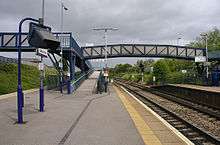

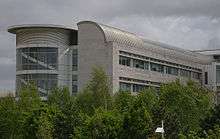
In the early 1990s, the Ministry of Defence procurement division was consolidated into a major office development in Filton, known as MoD Abbey Wood. As part of this development, a new station was built in Filton, primarily to serve the MoD workers. Construction began in 1995, and cost £1,400,000. The station, named Filton Abbey Wood, was opened to the public on 11 March 1996 and officially opened on 19 March by Minister for Transport Steven Norris MP and the Chair of Avon County Council.[22] Shortly after the station was opened, the county of Avon was disbanded, with the Filton region now governed by South Gloucestershire council.[30]
The new station was situated 23 chains (460 m) south of the first Filton station, and 34 chains (680 m) south of Filton Junction.[5][note 2] There were two platforms, each 108 metres (118 yd) long, separated by two running lines.[6] A ramped footbridge connected the platforms at the north end, and each platform had ground-level access from the sides: the eastern, southbound platform from MoD Abbey Wood; the western, northbound platform via a footpath from the car park to the north. There were metal and glass shelters on each platform and a small, rarely used booking office on the southbound platform.[22]
Initial services at the station included local stopping services from Bristol to South Wales, and services between Gloucester and Westbury. Services towards Bath were of particular importance to the MoD, as many of their staff had been based there prior to the construction of MoD Abbey Wood.[22] South Gloucestershire council provided a subsidy for half-hourly services to Bath.[31] The station proved popular with MoD workers, local residents commuting into central Bristol, and also students and staff at the University of the West of England.[22]
When the railway was privatised in 1997, local services were franchised to Wales & West,[32] which was succeeded by Wessex Trains, an arm of National Express, in 2001.[33] The line through Filton closed for two weeks in June 2004 to enable the construction of a new platform and third running line on the west side of the station, separating trains towards Bristol Parkway from trains towards Wales before the station, and so allowing through-trains to pass stopping trains.[6][34] The project cost £16,000,000,[35] and caused the complete suspension of Severn Beach Line services to allow longer-distance services to use it as a diversion.[36]
The Wessex franchise was amalgamated with the Great Western franchise into the Greater Western franchise from 2006, and responsibility passed to First Great Western, a subsidiary company of FirstGroup, and rebranded as Great Western Railway in 2015.[37][38][39][40] First introduced new services between Bristol Parkway and Weston-super-Mare, and between Cardiff Central and Taunton, each calling at Filton Abbey Wood.[41][42] From December 2006, Virgin CrossCountry began operating a single daily service Newcastle Central to Cardiff Central via Bristol Temple Meads and Filton Abbey Wood.[43][44] This service was taken over by Arriva CrossCountry when the CrossCountry franchise changed hands in 2007,[45] and then replaced by a daily service each direction between Cardiff Central and Manchester Piccadilly.[46]
| Preceding station | Historical railways | Following station | ||
|---|---|---|---|---|
| Bristol Parkway | Regional Railways Cross Country Route (1996–1997) |
Stapleton Road | ||
| Wales & West Cross Country Route (1997–2001) |
||||
| Wessex Trains Cross Country Route (2001–2006) |
||||
| Patchway | Regional Railways South Wales Main Line (1996–1997) |
Stapleton Road | ||
| Wales & West South Wales Main Line (1997–2001) |
||||
| Wessex Trains South Wales Main Line (2001–2006) |
||||
| Patchway | Virgin CrossCountry Cardiff - Newcastle (2006-2007) |
Bristol Temple Meads | ||
Future
First Great Western declined a contractual option to continue the Greater Western passenger franchise beyond 2013, citing a desire for a longer-term contract due to the impending upgrade to the Great Western Main Line.[39] The franchise was put out to tender,[47][48][49] but the process was halted and later scrapped due to the fallout from the collapse of the InterCity West Coast franchise competition.[50] A two-year franchise extension until September 2015 was agreed in October 2013,[51][52] and subsequently extended until March 2019.[53][54][55] The CrossCountry franchise is also due to expire in 2019.[56]
The line through Filton Abbey Wood was due to have been electrified by 2017 as part of the Great Western Main Line electrification project, however this has been postponed indefinitely.[12][57][58] The Cross Country Route, the Bristol to Exeter Line and the Heart of Wessex Line were not set to be electrified, so services at Filton Abbey Wood would still have been provided by diesel trains; however "Sprinter" units are expected to be replaced by Class 165 and 166 "Turbo" units.[59][60] The group Friends of Suburban Bristol Railways supports the electrification continuing beyond the main lines,[61][62] as does MP for Weston-super-Mare John Penrose.[63][64] The electrification scheme also includes the four-tracking of the line through Filton to allow more services between Bristol Parkway and Bristol Temple Meads and to separate fast inter-city services from local stopping services.[65][66][67]
Filton Abbey Wood is on the Weston-super-Mare/Yate corridor, one of the main axes of the Greater Bristol Metro, a rail transport plan which aims to enhance transport capacity in the Bristol area. The plan will also see the reopening of the Henbury Loop Line and the opening of a new station between Filton and Stapleton Road.[68][69][70]
Notes
- 1 2 3 4 5 6 There is some ambiguity about exactly when the first Filton railway station closed and the second opened. Butt's 1995 book[21] states 1886, but Oakley[22] and Maggs[23] both state 1903. 1903 would tie in with the new station being built as a junction for the GWR's Badminton Line, whereas 1886 would mean an entirely new station was built only months after the original station had a second platform built.
- 1 2 3 4 Railways in the United Kingdom are, for historical reasons, measured in miles and chains. There are 80 chains to the mile.
- ↑ Annual estimated passenger usage based on sales of tickets in stated financial year(s) which end or originate at Filton Abbey Wood, from Office of Rail and Road statistics. Methodology may vary year on year.
See also
References
- 1 2 OS Landranger Map 172 – Bristol & Bath. Southampton: Ordnance Survey. 2008. ISBN 978-0-319-22914-9.
- 1 2 3 A-Z Bristol and Bath Deluxe (2nd ed.). Sevenoaks, Kent: Geographers' A-Z Map Co. Ltd. 2003. ISBN 1-84348-099-9.
- 1 2 3 "Station facilities for Filton Abbey Wood (FIT)". National Rail. Retrieved 20 October 2013.
- 1 2 3 Baker, S.K. (2010). Rail Atlas of Great Britain and Ireland (12th ed.). Ian Allan. p. 28. ISBN 978-0-86093-632-9.
- 1 2 3 4 5 Deaves, Phil. "Engineers' Line References: BSW - Bristol and South Wales Union Line".
- 1 2 3 4 5 "Network Capability - Baseline Declaration: (1) Track and Route mileage: (2) Line-speeds: Western Route" (PDF). Network Rail. 1 April 2009. pp. 170–171. Retrieved 11 October 2013.
- ↑ "Filton Abbey Wood Station: Onward Travel Information" (PDF). Network Rail. 2012. Retrieved 20 October 2013.
- ↑ "Station Usage Estimates 2011/12". Office of Rail and Road. Retrieved 23 September 2013.
- ↑ "Station Usage Estimates 2002/03". Office of Rail and Road. Retrieved 23 September 2013.
- ↑ "Great Western Route Utilisation Strategy - Key Flows to/from Bristol" (PDF). Network Rail. 2006. Retrieved 23 September 2013.
- ↑ "Route 13: Great Western Main Line" (PDF). Network Rail. 2006. Retrieved 23 September 2013.
- 1 2 "Modernising the Great Western" (PDF). Network Rail. Retrieved 9 June 2012.
- 1 2 "Central 5: Guide to train times 8 December 2013 to 17 May 2014 - Bristol to Gloucester, Cheltenham Spa and the Malverns". First Great Western. November 2013. Retrieved 28 November 2013.
- ↑ "Central 4: Guide to train times 8 December 2013 to 17 May 2014 - Cardiff and Bristol to Weston-super-Mare and Taunton". First Great Western. November 2013. Retrieved 28 November 2013.
- 1 2 "Central 3: Guide to train times 8 December 2013 to 17 May 2014 - Cardiff and Bristol to the South Coast". First Great Western. November 2013. Retrieved 28 November 2013.
- 1 2 "Central 1: Guide to train times 8 December 2013 to 17 May 2014 - London to Bristol, Cheltenham Spa and South Wales". First Great Western. November 2013. Retrieved 28 November 2013.
- 1 2 3 "Manchester to the South West & South Coast" (PDF). CrossCountry. May 2013. Retrieved 29 September 2013.
- 1 2 "Scotland, the North East to the South West and South Coast" (PDF). CrossCountry. May 2013. Retrieved 29 September 2013.
- ↑ Miles, Tony (December 2010). "LOROL Class 150s all with FGW". Modern Railways. London. p. 90.
- 1 2 Salveson, Paul (June 2012). Abell, Paul, ed. "Severn Beach: Not your typical branch line!". Today's Railways. Sheffield: Platform 5 (126): 42–47.
- 1 2 3 Butt, R. V. J. (1995). The Directory of Railway Stations: details every public and private passenger station, halt, platform and stopping place, past and present (1st ed.). Sparkford: Patrick Stephens Ltd. p. 96. ISBN 1-8526-0508-1. OCLC 60251199.
- 1 2 3 4 5 6 7 8 9 10 11 12 13 14 15 16 17 Oakley, Mike (2003). Gloucestershire Railway Stations. Wimbourne, Dorset: The Dovecote Press. pp. 8–10, 69–71. ISBN 1-904349-24-2.
- 1 2 3 4 Maggs, Colin G (2008) [First published 1981]. Rail Centres: Bristol (#21) (3rd ed.). Nottingham: Booklaw Publications. pp. 10–38, 61, 66–67. ISBN 1-901945-30-8.
- ↑ MacDermot, E T (1931). History of the Great Western Railway, volume II 1863–1921. London: Great Western Railway.
- ↑ Robertson, Kevin; Abbot, David (1988). GWR: The Badminton Line - Portrait of a Railway. Alan Sutton Publishing. pp. 1–8. ISBN 0-86299-459-4.
- 1 2 Clark, R. H. (1986). An Historical Survey of Selected Great Western Stations - Layouts and Illustrations. 1. Poole: Oxford Publishing Company. ISBN 0-902888-29-3.
- ↑ Maggs, Colin (1975). The Bristol Port Railway and Pier. The Oakwood Press.
- ↑ Young, Robert. "CIVIC HERALDRY OF ENGLAND AND WALES-OBSOLETE COUNTIES: AVON". CivicHeraldry. Retrieved 29 October 2013.
- ↑ Thomas, David St John; Whitehouse, Patrick (1990). BR in the Eighties. Newton Abbot: David & Charles. ISBN 0-7153-9854-7.
- ↑ Orr, Linda; Lund, Michael (producers) (1996). "The End of Avon". BBC.
- ↑ "Rail commuter service maintained". BBC News. BBC. 24 February 2006. Retrieved 16 July 2012.
- ↑ Deaves, Phil (5 May 2015). "UK railway franchises". Retrieved 6 May 2015.
- ↑ "Wales and West". Wales & West. Archived from the original on March 14, 2012. Retrieved 9 June 2012.
- ↑ "Engineering works close main line". BBC News. BBC. 13 June 2004. Retrieved 29 October 2013.
- ↑ "Work on main rail line completed". BBC News. BBC. 3 July 2004. Retrieved 29 October 2013.
- ↑ "Notes and News: West Country Area - August 2004". Cardiff and Avonside Railway Society. August 2004. Retrieved 29 October 2013.
14/06 The diversions begin! All Wessex Trains local Severn Beach and Gloucester line services were replaced by road buses and EWS suspended Didcot import coal trains. This gave extra paths, Virgin XC operating a train each way every hour. The down trains departed from Parkway at 55 minutes past the hour leaving Temple Meads for the west at 44 minutes past the hour, whilst the up trains left at 25 minutes past the hour, destinations (and starting points) being York, Newcastle or Edinburgh via Derby. Wessex Trains 'Alphaline' services departed from Temple Meads at 10 minutes past the hour, normally 20 minutes later than usual. Some also called at Lawrence Hill, Stapleton Road and Patchway where there was a road bus connection to Parkway and Filton Abbey Wood. In the opposite direction, the usual 30 minutes past the hour services from Cardiff ran 10 minutes later, making similar calls and arriving at Temple Meads at 15 minutes past the hour (95 minutes from Cardiff) leaving at 22 minutes past the hour for Portsmouth Harbour. Running times between Parkway and Temple Meads was 30 minutes and between Patchway and Temple Meads around 35 minutes, resulting in some trains from Bristol to Cardiff standing at Patchway (leaving at 58 minutes past the hour) for about 10 minutes. The two passenger services each way over the Avonmouth loop was well within the capacity of the single line sections between Narroways junction and Hallen Marsh junction.
- ↑ "Wessex Trains". The Iron Road: Railway Photography by Scott Borthwick. Retrieved 29 September 2013.
- ↑ "FirstGroup wins rail franchises". BBC News. BBC. 13 December 2005. Retrieved 27 April 2012.
- 1 2 "First Great Western bids for longer rail franchise deal". BBC News. BBC. 11 May 2011. Retrieved 27 April 2012.
- ↑ "The Great Western Railway is back in business". Railnews. 21 September 2015. Retrieved 21 September 2015.
- ↑ "New rail service from Weston to Cardiff". Weston, Worle and Somerset Mercury. Archant Community Media. 8 December 2008. Retrieved 29 October 2013.
- ↑ "Longer trains pledge". Bath Chronicle. Northcliffe Media. 8 December 2008. Retrieved 29 October 2013.
- ↑ "Notes and News: West Country Area - February 2007". Cardiff and Avonside Railway Society. February 2007. Retrieved 29 October 2013.
11/12 ... One surprising adjustment for the new timetable was Virgin XC's 14.21 Voyager service, via Temple Meads which is now booked to call at Filton Abbey Wood (19.31), Patchway (19.36) and Severn Tunnel junction (19.47).
- ↑ "Accelerated services and additional stops in north feature in Virgin CrossCountry's December timetable" (Press release). Virgin Trains. 26 November 2006. Retrieved 29 October 2013.
The southbound call at Gloucester will now be made by the 14:21 train from Newcastle to Cardiff which will call additionally at Filton Abbey Wood, Patchway and Severn Tunnel Junction.
- ↑ "New rail franchise to increase capacity between major cities" (Press release). Department for Transport. 10 July 2007. Archived from the original on August 12, 2007. Retrieved 29 September 2013.
- ↑ "NEW CROSS COUNTRY FRANCHISE Service Level Commitment TWO" (PDF). Department for Transport. October 2011. Retrieved 29 October 2013.
- ↑ Haigh, Philip (18 April 2012). "First leads a field of seven bidding for rail franchises". RAIL magazine. Peterborough: Bauer Media (694): 8–9.
- ↑ "Great Western franchise to be extended". Railnews. 19 July 2012. Retrieved 19 July 2012.
- ↑ "New Great Western franchise to deliver new express trains" (Press release). Department for Transport. 27 July 2012. Retrieved 29 July 2012.
- ↑ "Great Western London to south Wales rail contest scrapped". BBC News. BBC. 31 January 2013. Retrieved 31 January 2013.
- ↑ "First celebrates last-minute Great Western deal". Railnews. 3 October 2013. Retrieved 4 October 2013.
- ↑ "First Great Western retains Wales and west rail franchise". BBC News. BBC. 3 October 2013. Retrieved 4 October 2013.
- ↑ "First Great Western offered new franchise deal". BBC News. BBC. 10 October 2014. Retrieved 10 October 2014.
- ↑ "FirstGroup wins Great Western contract extension". The Guardian. Guardian Media Group. 10 October 2014. Retrieved 10 October 2014.
- ↑ "Updated franchise schedule signals GW extension". Railnews. 10 October 2014. Retrieved 10 October 2014.
- ↑ McLoughlin, Patrick (26 March 2013). "Written statement to Parliament - Rail franchising" (Press release). Department for Transport. Retrieved 5 October 2013.
- ↑ "Bristol to London line to be electrified". This Is Bristol. Northcliffe Media. 23 July 2009. Retrieved 5 April 2012.
- ↑ "Further delays to GWML electrification as schemes deferred indefinitely". Rail Technology Magazine. 8 November 2016. Retrieved 8 November 2016.
- ↑ "Weston-super-Mare to London rail re-franchise concerns". BBC News. BBC. 10 August 2012. Retrieved 13 August 2012.
- ↑ Clinnick, Richard (15 April 2015). "How the West will win with new trains". RAIL magazine. Peterborough: Bauer Media (772): 58–59. Retrieved 12 October 2015.
- ↑ "Benefits of Bristol to London high-speed rail link 'must go beyond just mainline'". This Is Bristol. Northcliffe Media. 3 March 2011. Retrieved 5 April 2012.
- ↑ "FoSBR Newsletter" (PDF). Friends of Suburban Bristol Railways. Autumn 2011. Retrieved 9 April 2012.
- ↑ Penrose, John (17 July 2009). "Weston's rail commuter services could be cut, warns town's MP" (Press release). Retrieved 2012-04-05.
- ↑ "MP takes drive for better rail services to top". This Is Bristol. 29 October 2011. Retrieved 5 April 2012.
- ↑ "Green light for long-awaited rail improvements". The Post, Bristol. Northcliffe Media. 17 July 2012. Retrieved 29 September 2013.
- ↑ Broadbent, Steve (16–29 May 2012). "Ship-shape and Bristol fashion". RAIL (696): 46–53.
- ↑ "Bristol Temple Meads and Parkway get extra tracks". BBC news. BBC. 30 October 2014. Retrieved 30 October 2014.
- ↑ White, James (13 March 2009). "Item 04: Greater Bristol Metro" (PDF). West of England Partnership. Retrieved 28 December 2011.
- ↑ "Campaign for trains from Bristol Temple Meads every half hour". This Is Bristol. Northcliffe Media. 17 January 2012. Retrieved 19 January 2012.
- ↑ Ribbeck, Michael (6 July 2012). "£100 million Bristol Metro train network by 2016". The Post, Bristol. Northcliffe Media. Retrieved 6 July 2012.
External links
| Wikimedia Commons has media related to Filton Abbey Wood railway station. |
| Wikimedia Commons has media related to Filton Junction railway station. |
